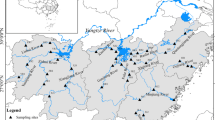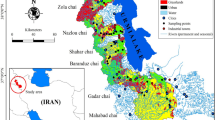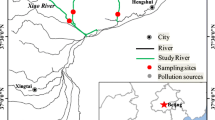Abstract
The concentration partitioning between the sediment particle and the interstitial water phase plays an important role in controlling the toxicity of heavy metals in aquatic systems. The aim of this study was to assess the sediment quality in a polluted area of the Ziya River, Northern China. The contamination potential and bioavailability of six metals were determined from the concentrations of total metals and the bioavailable fractions. The results showed that the concentrations of Cr, Cu, Ni, Zn, and Pb exceeded the probable effect concentration at several sites. The high geoaccumulation indices showed that the sediments were seriously contaminated by Cd. The ratio of acid-volatile sulfide (AVS) to simultaneously extracted metal (SEM) was higher than 1, which indicated that the availability of metals in sediments was low. The risk assessment of interstitial waters confirmed that there was little chance of release of metals associated with acid-volatile sulfide into the water column. Values of the interstitial water criteria toxicity unit indicated that none of the concentrations of the studied metals exceeded the corresponding water quality thresholds of the US Environmental Protection Agency. Positive matrix factorization showed that the major sources of metals were related to anthropogenic activities. Further, if assessments are based on total heavy metal concentrations, the toxicity of heavy metals in sediment may be overestimated.






Similar content being viewed by others
References
Adams WJ, Kimerle RA, Barnett JW Jr (1992) Sediment quality and aquatic life assessment. Environ Sci Technol 26:1864–1875
Ankley GT, Di Toro DM, Hansen DJ, Berry WJ (1996) Technical basis and proposal for deriving sediment quality criteria for metals. Environ Toxicol Chem 15:2056–2066
Arfaeinia H, Nabipour I, Ostovar A, Asadgol Z, Abuee E, Keshtkar M, Dobaradaran S (2016) Environmental Science & TechnologyAssessment of sediment quality based on acid-volatile sulfide and simultaneously extracted metals in heavily industrialized area of Asaluyeh, Persian gulf: concentrations, spatial distributions, and sediment bioavailability/toxicity. Environ Sci Pollut Res 23:9871–9890
Bhuiyan MAH, Dampare SB, Islam M, Suzuki S (2015) Source apportionment and pollution evaluation of heavy metals in water and sediments of Buriganga River, Bangladesh, using multivariate analysis and pollution evaluation indices. Environ Monit Assess 187:1–21
Brown S, Lee T, Norris G, Roberts P, Collett J Jr, Paatero P, Worsnop D (2012) Receptor modeling of near-roadway aerosol mass spectrometer data in Las Vegas, Nevada, with EPA PMF. Atmos Chem Phys 12:309–325
Brown SG, Eberly S, Paatero P, Norris GA (2015) Methods for estimating uncertainty in PMF solutions: examples with ambient air and water quality data and guidance on reporting PMF results. Sci Total Environ 518:626–635
Burgess RM, Berry WJ, Mount DR, Di Toro DM (2013) Mechanistic sediment quality guidelines based on contaminant bioavailability: equilibrium partitioning sediment benchmarks. Environ Toxicol Chem 32:102–114
CNEMC (1990) The background values of Chinese soils. Environmental Science Press of China, Beijing, pp. 67–85
Deng GP, Yang WQ, Zhou GY, Li Y, Liu SL (2014) Heavy metals and polycyclic aromatic hydrocarbons in sediments from the Shenzhen River, South China. Environ Sci Pollut Res 21:10594–10600
Di Toro DM, Mahony JD, Hansen DJ, Scott KJ, Hicks MB, Mayr SM, Redmond MS (1990) Toxicity of cadmium in sediments: the role of acid volatile sulfide. Environ Toxicol Chem 9:1487–1502
Farkas A, Erratico C, Vigano L (2007) Assessment of the environmental significance of heavy metal pollution in surficial sediments of the River Po. Chemosphere 68:761–768
Hsieh Y, Shieh Y (1997) Analysis of reduced inorganic sulfur by diffusion methods: improved apparatus and evaluation for sulfur isotopic studies. Chem Geol 137:255–261
Hu BQ, Li J, Zhao JT, Yang J, Bai FL, Dou YG (2013) Heavy metal in surface sediments of the Liaodong Bay, Bohai Sea: distribution, contamination, and sources. Environ Monit Assess 185:5071–5083
Huston R, Chan Y, Chapman H, Gardner T, Shaw G (2012) Source apportionment of heavy metals and ionic contaminants in rainwater tanks in a subtropical urban area in Australia. Water Res 46:1121–1132
Khan MF, Hirano K, Masunaga S (2012) Assessment of the sources of suspended particulate matter aerosol using US EPA PMF 3.0. Environ Monit Assess 184:1063–1083
Krčmar D, Prica M, Dalmacija B, Watson M, Tričković J, Rajić L, Tamaš Z (2013) Correlation of different pollution criteria in the assessment of metal sediment pollution. J Environ Sci Heal A 48:380–393
Kucuksezgin F, Uluturhan E, Batki H (2008) Distribution of heavy metals in water, particulate matter and sediments of Gediz River (eastern Aegean. Environ Monit Assess 141:213–225
Long ER (2006) Calculation and uses of mean sediment quality guideline quotients: a critical review. Environ Sci Technol 40:1726–1736
Lourino-Cabana B, Lesven L, Charriau A, Billon G, Ouddane B, Boughriet A (2011) Potential risks of metal toxicity in contaminated sediments of Deûle river in northern France. J Hazard Mater 186:2129–2137
Ma XL, Zuo H, Tian MJ, Zhang LY, Meng J, Zhou XN, Min N, Chang XY, Liu Y (2016) Assessment of heavy metals contamination in sediments from three adjacent regions of the Yellow River using metal chemical fractions and multivariate analysis techniques. Chemosphere 144:264–272
MacDonald DD, Ingersoll CG, Berger T (2000) Development and evaluation of consensus-based sediment quality guidelines for freshwater ecosystems. Arch Environ Con Tox 39:20–31
Muller G (1969) Index of geoaccumulation in sediments of the Rhine River. Geo Journal 2:108–118
Norris G, Vedantham R, Wade K, Brown S, Prouty J, Foley C (2008) EPA positive matrix factorization (PMF) 3.0 fundamentals & user guide. Prepared for the US Environmental Protection Agency, Washington, DC, by the National Exposure Research Laboratory, Research Triangle Park
Okay OS, Pekey H, Morkoç E, Başak S, Baykal B (2008) Metals in the surface sediments of Istanbul Strait (Turkey). J Environ Sci Heal A 43:1725–1734
Pardo R, Barrado E, Lourdes P, Vega M (1990) Determination and speciation of heavy metals in sediments of the Pisuerga River. Water Res 24:373–379
Praipipat P, Rodenburg LA, Cavallo GJ (2013) Source apportionment of polychlorinated biphenyls in the sediments of the Delaware River. Environ Sci Technol 47:4277–4283
Prica M, Dalmacija B, Rončević S, Krčmar D, Bečelić M (2008) A comparison of sediment quality results with acid volatile sulfide (AVS) and simultaneously extracted metals (SEM) ratio in Vojvodina (Serbia) sediments. Sci Total Environ 389:235–244
Rodenburg LA, Delistraty D, Meng QY (2015) Polychlorinated biphenyl congener patterns in fish near the Hanford site (Washington state, USA. Environ Sci Technol 49:2767–2775
Roig N, Sierra J, Moreno-Garrido I, Nieto E, Gallego EP, Schuhmacher M, Blasco J (2016) Metal bioavailability in freshwater sediment samples and their influence on ecological status of river basins. Sci Total Environ 540:287–296
Roosa S, Prygiel E, Lesven L, Wattiez R, Gillan D, Ferrari BJD, Criquet J, Billon G (2016) On the bioavailability of trace metals in surface sediments: a combined geochemical and biological approach. Environ Sci Pollut Res 23:10679–10692
Sinha S, Mishra RK, Sinam G, Mallick S, Gupta AK (2013) Comparative evaluation of metal phytoremediation potential of trees, grasses, and flowering plants from tannery-wastewater-contaminated soil in relation with physicochemical properties. Soil Sediment Contam 22:958–983
Sterckeman T, Douay F, Proix N, Fourrier H (2000) Vertical distribution of Cd, Pb and Zn in soils near smelters in the north of France. Environ Pollut 107:377–389
Suresh G, Sutharsan P, Ramasamy V, Venkatachalapathy R (2012) Assessment of spatial distribution and potential ecological risk of the heavy metals in relation to granulometric contents of Veeranam lake sediments, India. Ecotox Environ Safe 84:117–124
Tang W, Zhao Y, Wang C, Shan B, Cui J (2013) Heavy metal contamination of overlying waters and bed sediments of Haihe Basin in China. Ecotox Environ Safe 98:317–323
Tang W, Zhang H, Shan B, Li S (2014) Accumulation and risk assessment of sedimentary trace metals in response to industrialization from the tributaries of Fuyang River system. Environ Earth Sci 73:1975–1982
Teixeira EC, Agudelo-Castaneda DM, Mattiuzi CD (2015) Contribution of polycyclic aromatic hydrocarbon (PAH) sources to the urban environment: a comparison of receptor models. Sci Total Environ 538:212–219
Tessier A, Campbell PG, Bisson M (1979) Sequential extraction procedure for the speciation of particulate trace metals. Anal Chem 51:844–851
U.S.EPA (2005) Procedures for the derivation of equilibrium partitioning sediment benchmarks (ESBs) for the protection of benthic organisms: metal mixtures (cadmium, copper, lead, nickel, silver and zinc). Office of Research and Development, Washington, DC 20460
Wang T, Cheung TF, Li YS, Yu XM, Blake DR (2002) Emission characteristics of CO, NOx, SO2 and indications of biomass burning observed at a rural site in eastern China. J Geophy Res-Atmos. doi:10.1029/2001JD000724
Wang YB, Liu CW, Wang SW (2015) Characterization of heavy-metal-contaminated sediment by using unsupervised multivariate techniques and health risk assessment. Ecotox Environ Safe 113:469–476
Yekta SS, Gustavsson J, Svensson BH, Skyllberg U (2012) Sulfur K-edge XANES and acid volatile sulfide analyses of changes in chemical speciation of S and Fe during sequential extraction of trace metals in anoxic sludge from biogas reactors. Talanta 89:470–477
Yu KC, Tsai LJ, Chen SH, Ho ST (2001) Chemical binding of heavy metals in anoxic river sediments. Water Res 35:4086–4094
Yu G, Liu Y, Yu S, Wu SC, Leung AOW, Luo XS, Xu B, Li HB, Wong MH (2011) Inconsistency and comprehensiveness of risk assessments for heavy metals in urban surface sediments. Chemosphere 85:1080–1087
Zahra A, Hashmi MZ, Malik RN, Ahmed Z (2014) Enrichment and geo-accumulation of heavy metals and risk assessment of sediments of the Kurang Nallah-feeding tributary of the Rawal Lake reservoir, Pakistan. Sci Total Environ 470:925–933
Zhang J, Liu C (2002) Riverine composition and estuarine geochemistry of particulate metals in China—weathering features, anthropogenic impact and chemical fluxes. Estuar Coast Shelf S 54:1051–1070
Zhang H, Shan B (2008) Historical records of heavy metal accumulation in sediments and the relationship with agricultural intensification in the Yangtze–Huaihe region, China. Sci Total Environ 399:113–120
Zhu XL, Shan BQ, Tang WZ, Li SS, Rong N (2016) Distributions, fluxes, and toxicities of heavy metals in sediment pore water from tributaries of the Ziya River system, northern China. Environ Sci Pollut Res 23:5516–5526
Acknowledgments
This research was supported by the Major Science and Technology Program for Water Pollution Control and Treatment (No. 2012ZX07203-006); the special fund from the State Key Joint Laboratory of Environment Simulation and Pollution Control (Project No. 15L01ESPC); the National Natural Science Foundation of China (No. 21107126).
Author information
Authors and Affiliations
Corresponding authors
Additional information
Responsible editor: Stuart Simpson
Electronic supplementary material
ESM 1
(DOCX 36 kb)
Rights and permissions
About this article
Cite this article
Zhu, X., Shan, B. & Tang, W. Heavy metal in sediments of Ziya River in northern China: distribution, potential risks, and source apportionment. Environ Sci Pollut Res 23, 23511–23521 (2016). https://doi.org/10.1007/s11356-016-7561-9
Received:
Accepted:
Published:
Issue Date:
DOI: https://doi.org/10.1007/s11356-016-7561-9




